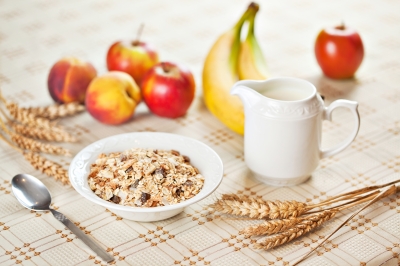4 Reasons Why You Need More Fiber
 How many grams of fiber do you consume daily?
How many grams of fiber do you consume daily?
Most Americans consume half the recommended dietary intake of 25 grams (women) to 38 grams (men) of fiber daily for adults 50 years or younger. Over the age of 50, women should consume 21 grams of fiber and men 30 grams per day.
There are two types of fiber.
Soluble fiber turns to a gel during digestion. Sources of soluble fiber include oats, oatmeal, nuts, seeds, beans, peas, lentils, and some fruits and vegetables (i.e. oranges, apples, carrots).
Insoluble fiber is not digested. It adds bulk to the stool and helps food move through the stomach and intestines. Sources of insoluble fiber include vegetables, whole-grains, and wheat bran.
A diet high in fiber is connected to many health benefits.
- Lower cholesterol levels
- Increased satiety
- Reduced colon cancer risk
- Reduced risk of type II diabetes
Boosting fiber intake from whole-grain products leads to a slower build-up of arterial plaque. Studies also find soluble fiber to protect against atherosclerosis, which is this build-up of plaque in the arterial walls.
Dietary fiber also binds to LDL cholesterol during digestion, resulting in lower LDL cholesterol levels, without decreasing HDL cholesterol levels.
Satiety is that feeling of fullness you have after eating. Satiety impacts the length of time between meals/snacks, which in turn can impact how many calories you consume throughout the day.
High fiber foods typically require more chewing, which means meal times take longer and further increase feeling of satiety. This means high fiber meals/snacks may lead to fewer calories consumed during meal/snack times. (FYI – It can take ~20 minutes for the stomach to communicate to the brain you are full. Take your time eating!)
Many studies have evaluated the impact of fiber on satiety. Whole grain rye, rye bran, beta-glucan from oats and barley are the fiber sources most consistently connected to increased satiety.
Fiber adds bulk to your digestive system and stools. This bulk tends to shorten the amount of time waste travels through the colon. Waste often contains carcinogens, so this shortened travel time is desirable to more quickly eliminate harmful substances and reduce the risk of intestinal cells being impacted.
When fiber is broken down in the intestine, the substance butyrate is produced. It’s possible butyrate may inhibit tumor growth.
While fiber is a type of carbohydrate, it does not raise blood glucose levels since it is not digested. Studies find a diet high in fiber promotes reduced fasting blood glucose levels and hemoglobin A1C. Hemoglobin A1c measures your average blood glucose levels over the past 2-3 months. Dietary fiber is a desirable addition to your diabetes treatment plan.
Additional health benefits that have been connected to dietary fiber include improved/prevention of constipation and improved absorption of certain vitamins and minerals.
Do not suddenly go from 15-grams of fiber daily up to 35-grams. A sudden increase will lead to gastric distress. Gradually increase your intake of dietary fiber and drink plenty of water.
For more guidance to lower cholesterol levels, access the free ecourse “How to Lower Cholesterol in 8 Simple Steps” at http://lowercholesterolwithlisa.com/.
Lisa Nelson RD
Health Pro for HealthCentral
Image courtesy of Serge Serge Bertasius Photography/FreeDigitalPhotos.net



